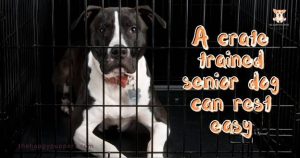Why is Puppy Crate Training important?


Are you wondering if puppy crate training is a good option for your dog? If yes, then you have landed in the right place. Keep on reading all the way to the end to know the advantages of having a crate-trained dog. You will also know why you should get puppy crate training done at an early age.
Why bother with puppy crate training?
Growing up, crates always seemed like a cruel option. However, I never had a dog growing up. Therefore, the concept of puppy crate training it’s something I came to know of until recent years. Contrary to popular beliefs, that keeping your dog in a cage is cruel, crates can actually provide a safe and secure environment to the pup, allowing him to relax when the environment around him seems confusing.
Before I get into the process and advantages of puppy crate training, you need to understand what is a puppy crate in the first place.
What is a puppy crate?
Flight kennel is the other name of puppy crate. Dog crates are made of collapsible metal or plastic. Puppy or dog crates are enclosed pens. They are only big enough to allow the dog to stand up and turn around. Crate can act as a sanctuary for your dog and as a hiding spot. The purpose of the puppy or dog crate is to provide your dog with confinement. Your dog’s movement may be restricted for various reasons:
- to keep your dog safe
- for dog training
- to prevent excessive chewing behavior
and other reasons.

The positive and negative ways of puppy crate training
Puppy crate training can be used in one of two ways. Dog guardians can either crate train their dog in the right or wrong manner. If you train your dog in the wrong manner and use the crate as a sign of punishment, this type of puppy crate training will not yield good results. Those who have read my other blog posts would know that I always favor positive reinforcement methods for dog training.
If the puppy crate training is done in a positive manner, the crate will act as a safe environment for the dog. The dog will use the crate as an escape route when he is in any kind of distress. However, how your dog will see the crate will entirely depend on how you conduct the puppy crate training process in the first place.
Importance of crate training for puppies
Before I get into the importance of crate training for puppies, you must understand that puppy crate training can be a useful resource during the dog training process. Furthermore, you can also have your dog ready to deal with any kind of emergency situation. To better understand how puppy crate training can be useful, keep reading…
Helps in the house-training process.
The moment you get a new puppy, the first order of business that you have to conduct is to get your puppy house trained. Every dog guardian dreams of having a dog who knows where exactly to do their business. Puppy crate training can prove to be very useful in the house-training process
Dog moms teach their puppies that they are not to soil the region where they sleep. When your puppy learns to associate the crate with sleeping quarters, they will try to not pee or poop in the crate. This is because they prefer to keep their sleeping areas clean.
A crate is a place where the puppy sleeps. Therefore, the puppy will prefer not to mess with the crate. This will teach the puppy to hold the bladder when in the crate. This will also reduce the level of mess that you have to clean up in your household during the house training process.

Extremely helpful during emergencies.
God forbid, if you ever get stuck in an emergency, you will not have a lot of time to give instruction to your dog. If for any reason, you need to get out of your house fast, the crate is the easiest way to take your dog out safely and without any injury. If you have already conducted puppy crate training and your puppy is crate trained, you can ask your pup to get into the crate during an emergency. You can pick up the crate and leave the house.
If your dog is secured during the process of evacuation, there is less chance that he will get injured or lost. If you have to live in a shelter, it will be easier to have your dog with you if he has been previously crate trained. As per the rules, dogs must be crate trained if they are to stay in the shelters alongside their owners.
Let’s look at another scenario. Suppose you have not to crate trained your dog. During an emergency, your dog will run helter-skelter because he is anxious and nervous. It will be difficult to calm your dog down or take him out. Thus, not conducting puppy crate training can lead to serious consequences in case of emergencies.
Boon for senior dogs
If you have a senior dog in your home, you know that he prefers to spend more time resting and less time playing. If your dog has been previously crate trained, he can go to the crate and relax. There are many different scenarios where puppy crate training can come in very handy for your senior dog.
Your dog is tired and wants to rest
Senior dogs get tired very easily. The time has caught up with them and now they prefer to rest more and play less. The crate can provide a safe haven to your dog to rest. This way, the dog will not be in your path while you work around the house. His sleep will also not be disturbed if he is in the crate. He can rest as long as he wants in the crate and come out when he is rejuvenated and ready.
Helps in getting the pup to the vet
Having a crate trained dog will also help you transport him to the vet for consultation. Suppose your dog suffers from a debilitating disease like arthritis, dementia, canine cognitive dysfunction, or incontinence. Under such conditions, it will be easier to transport your dog to the vet by taking him in the crate directly. It will allow your dog more time to rest and he will feel less exhausted.

Provides a safe space
Alternatively, if your dog is suffering from dog cataracts, the crate will prevent him from knocking into objects. The dog can stay in the safe and familiar environment of the crate and not get hurt by things around the house.
You have a new puppy in the home
Puppies are a bundle of energy. Even though puppies sleep a lot, they play for every waking moment that they have. Therefore, if you have a senior dog in your home and you recently got a new puppy, having your elder dog crate trained can be very useful during such periods.
Dealing with a puppy can be exhausting. Your senior dog will get tired of the new puppy’s shenanigans. Thus, he can rest in the crate. It will be much easier to teach the puppy to not disturb the dog when he is in the crate than outside.
Safe from kids
Puppy crate training is the best way to keep your senior dog safe from crates. Just like puppies, kids also have a lot of energy. They also try to maximize every waking moment by engaging or playing with the dog. However, if your dog is not feeling up to it, he can easily go into the crate. This would indicate that he is not willing or in the mood to play with the kids.
Your dog is in post-surgery care
This point applies to both young and old dogs alike. Suppose your dog had surgery recently. Movement restriction is advised while the incision heals. Under such conditions, it is advisable that your dog does not engage in any rambunctious activity.
A dog crate only provides enough room for the dog to stand and turn around. Therefore, the dog will not be able to engage in any strenuous activity while being inside the crate. Even if your young dog or puppy wants to jump around, it will not be possible because of the confines of the crate. Therefore, you will have peace of mind that your dog is safe and will not rupture the sutures.
If you have a senior dog who has recently undergone surgery, the crate can be a massive help. If your dog has previously been crate trained, he can stay in the crate healing from the trauma of the surgery. Senior dogs anyways are unlikely to engage in the rambunctious activity. Thus, leave the door of the crate open while the dog is resting inside,
Transportation
Puppy crate training can come in very handy during the transportation process, whether by car or plane.
Travel by car
If you have crate trained your dog, long-distance travel or going on vacations by road can be an absolute dream. Your dog can stay in the crate during the car rides. This will make it easier for both dogs and humans to travel. The dog can easily lay down in the crate and drift off to sleep without worrying or distracting the driver. This will also help keep the interiors of your car clean and reduce the accumulation of dog fur in the floor mats and the seat of the car.
Suppose the dog is not crate trained. During long-distance travels, the dog would want to move around. This can distract the driver and can lead to a dangerous situation on the road. Thus, get the dog crate trained to ensure safe travels. If your dog is one who peacefully sits at a place and stares out the window, then you do not have to confine him to a crate.

Travel by plane
If your dog has been previously crate trained, it will be much easier to transport him via airplane. However, you need to train your dog to properly behave while in the crate. During airplane transport, dog crates stay confined to the baggage section.
In most cases, guardians provide their dogs with either CBD oil treats or other sedatives so that the dogs remain calm during the flight. However, it is not advisable to follow this route of action since sedation increases the chance of respiratory or heart problem occurrence in dogs.
Puppy crate training can help if your dog suffers from anxiety
Even if your dog does not suffer from anxiety specifically, there may be situations when your dog may feel anxious like
- Fireworks going off
- People screaming or shouting
- Loud noises from a nearby construction
- Thunderstorm
- Separation anxiety
Under such conditions, your dog can retreat to the crate and use it as a safe zone. If you have a dog who is afraid of fireworks or thunderstorms, give the crate, a cave-like appearance. You can cover the crate with blankets. Put your dog’s favorite blanket, pillow, and toys inside the crate so that your dog feels comfortable and at home when inside the crate. If it is the noise that is bothering your dog, you can also put up some soothing music in the crate to help calm your puppy down.
Your dog will not know that the crate is the place to go when he is feeling anxious. For this, you will have to train your dog to recognize the crate as a safe space. Once you have successfully crate trained your dog, whenever he feels anxious due to the noises from the thunderstorm or fireworks, he will immediately retreat to the crate and use it for safety and assurance.
Related post: Separation anxiety treatments

Benefits of crate training for rescues
If you have a rescue dog, I would advise you to start with the process of getting him crate trained first. This way the new dog will have a safe place to go to if things become hard to handle. The crate will act as a safe zone for the new dog while they adjust to the new environment. The dog will also learn that the space in the crate belongs to him and he does not have to fight for it.
Related post: Training rescue terriers
Allows for easy and quick settling in
Sometimes, rescue dogs may be afraid of their environment or the people around them. This especially occurs in dogs with traumatization or abuse history. The crate will allow the dog to settle in quickly since it will provide him with a safe space. The crate will provide the dog with a territory that he owns and does not have to defend himself from others.
Related post: Why punishing your dog doesn’t work?
Crate training in puppies will also help you prevent other destructive problems like excessive chewing behavior. Suppose you leave your dog (suffering from separation anxiety) alone in the house. Chances are, you will come back to a house with destroyed furniture. Thus, while you are out running errands, the dog can peacefully stay in the crate and feel safe. A word of advice: do not leave your dog in the crate for over 2 hours at a time.
Many times, rescue dogs have socialization issues. If you have other dogs in your house, the new dog may feel fearful or aggressive. If you can successfully crate train the new dog, the socialization process will also become easier since the dog will have his own territory. When the dog does not have to fight for his territory, he will feel much more relaxed and socialization will become easier.
To summarize
There are many reasons why you should opt for puppy crate training.

As the dog guardian, the benefits you will reap are:
- Have peace of mind when you go out to run errands. You will know that you’ll get back to a house with full furniture. Crate training in puppies will keep bad habits at bay like excessive chewing, etc.
- The dog becomes much easier to house train since they do not soil the region where they sleep.
- You can put your dog in the crate during an emergency situation. For example: evacuating under a house fire.
- Can help avoid anxiety due to the presence of other people, thunderstorms, fireworks and other loud noises.
- Allows for safe travel options.
The benefits your dog will reap are:
- Have his own den where he can retreat when he is not feeling well, tired, or stressed.
- A territory that he will not have to defend from anyone.
- Will learn to control bowel movements and associate peeing and pooping with outdoors.
- Your dog can go with you on trips and long drives
- Will feel less lonely
- Will heal faster during post-surgery care.
Conclusion
Now you know the importance of puppy crate training. If you are getting home a new puppy, you should be ready to start crate training for puppies at the earliest stages possible. The sooner you get your dog crate trained, the easier life will become for both you and your dog.
You must understand that you will not get your dog successfully crate trained within a day or a week. The process of puppy crate training is a long one. You will require a lot of patience, treats, and positive reinforcements to get through the training process. But, if you are successful in training your dog, the rewards will be amazing.
Want to know how to crate train your dog? Subscribe to The Happy Puppers so that when I release the next blog post on how to crate train your dog, you will receive a notification in your email. This way, you will never miss out on any of the new blog post releases. If you love watching videos, please subscribe to the YouTube channel of The Happy Puppers and ring the notification bell. YouTube will notify you when a new video releases.
Pin this article for later:

Have you crate trained your dog? How did you achieve this process? Did you have a go-to method for crate training? Does your dog use the crate every day, or is it only during emergencies? Please share your experiences, opinions, and comments in the comment section below. Your experience can help make the dog training process better for other dog guardians. If you have any queries pertaining to this blog post or any other article on The Happy Puppers blog, please feel free to reach out to me on any of my social media channels. You can also email me with your query. I will be happy to help.
See you in my next blog post






